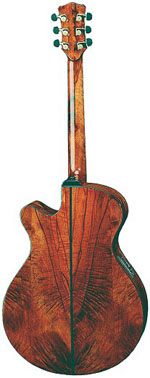Luthier supply houses over here? No, no such beast I'm afraid. There's a few local guitar makers who sell some supplies on the side, mostly stuff from Stewmac or LMI, imported and marked-up considerably.
There are quite a few local woods that are suitable for guitar making, most notably Acacia melanoxylon (Australian or Tasmanian blackwood) this is expensive though. Another is Grevillea Robusta locally known as (southern) silky oak, that you probably know as lacewood, this is commonly available at most lumber yards and quite inexpensive. Queensland maple has also been used for backs and sides and necks. Eucalyptus marginata aka Jarrah is inexpensive and has also been used on guitar back and sides with some sucess. There are a few other possibilities that I plan on investigating, Tasmainian Myrtle should prove to be suitable as the density, elasticity, hardness etc seem to be in the right ballpark, and it has fiddleback figure that looks very nice, and reportedly bends easily, though I've never heard of it being used in guitars. There are many others that are possibilities, but I won't know for sure until I get my new bandsaw and start building with them.
As for top woods, there are not many, in our harsh climate, hardwoods (and I mean HARD!) are more common. Reported as being the best sound board is King William Pine, unfortunatly this is very difficuult to get due to over logging in the past, it is still obtainable but expensive, the best source would be recycled. Another possibility is cellery top pine, it is inexpensive and easily available.
Don't pay any attention to whether these woods are called oak, myrtle, or pine because they aren't even remotly related to those species. When Australia was first settled, names were given to timbers that resembled northern hemisphere species. So that anything having strong medullary rays was an oak, if it was a conifer it was called a pine. For example king william pine (aka king billy pine) is more closly related to a redwood than a pine tree.
I think that many of the most promising are probably Tasmanian timbers, you can find more info on tassy timber here: http://www.tastimber.tas.gov.au/
Here's a link that I found on mimf to an excel spreadsheet that someone has put together on Australian timbers used in lutherie:
ftp://www.mimf.com/pub/aus_timber.zip
Hope this helps,
PaulPaulB38429.024525463
|




